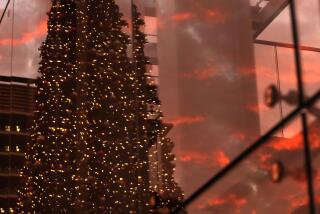Ted Danson Hosts a Benefit for Futures for Children
- Share via
It was early Sunday afternoon at the Futures for Children benefit and host Ted Danson, tall and rangy as a Texas cowboy, was standing in the entry of his Santa Fe-style home in Santa Monica Canyon, greeting guests and talking about his youth. How he grew up in Flagstaff, Ariz., where he hung out with Hopi and Navaho children, and how today his involvement with Futures for Children is “kind of a pay-back to my childhood.”
Suddenly a broad grin spread across his face and he began to laugh. His daughter, Alexis, 3 1/2, had made an appearance. Padding in with a bucket, a doll and several other stuffed toys, she had plopped herself down on the floor, oblivious to the commotion around her, and was playing quietly. Danson let her be. “Life goes on in the Danson house,” he said.
Private Exhibition
Easy and comfortable, this party was. Throw on some jeans or a long skirt and boots, haul out all your silver and turquoise jewelry, toss the kids in the car and come on over for a private exhibition of sculptures by Apache artist Allan Houser, some colorful Zuni and Eagle dancers and an authentic New Mexico lunch prepared by Chez Vous Catering from Casey Danson’s New Mexico cookbooks. There was even Indian fry bread made on the spot by Crucita and Dolorita Melchor, who’d flown in from the San Domingo reservation near Albuquerque for the occasion.
Naturally, the “Cheers’ ” cast was there: George Wendt entering with a toddler clinging to one hefty arm, Kirstie Alley, Rhea (Perlman) and Danny DeVito’s two girls racing around with the Dansons’ Kate and Alexis. Ann Miller observed the Zuni dancers from a far table with theater impresario Jimmy Doolittle, and Paul Winfield stood around the drinks table watching the Corona beer disappear.
If the atmosphere was low-keyed, the idea was definitely big money. According to president Ruth T. Frazier, Futures for Children, a nonprofit organization headquartered in Albuquerque, gets no federal or state funding for its educational and self-help programs among Southwest Indians. “So we get very creative with our fund raising,” she said.
Tickets were $250 per couple. For that, contributors were immediately mailed a copy of a new art book on Houser, “so we could come prepared,” Neil Konigsberg noted. Once there, you could buy a sculpture or two (prices ranged from $650 to $125,000) or, on a slightly less extravagant level, Indian-made rugs and jewelry. The result: $80,000 net, which should make a nice impact on Futures’ $1-million annual budget. In addition, 37 new sponsorships for Indian children were established.
More to Read
Sign up for Essential California
The most important California stories and recommendations in your inbox every morning.
You may occasionally receive promotional content from the Los Angeles Times.












